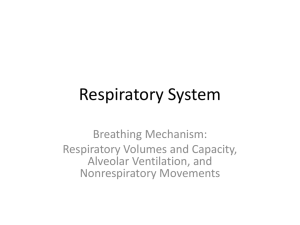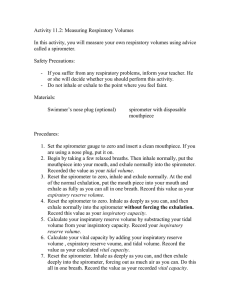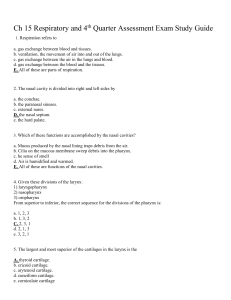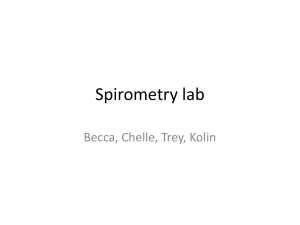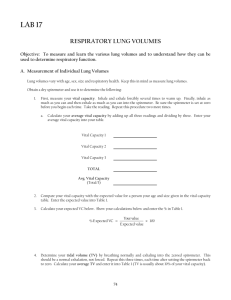Circulatory and Respiratory Systems
advertisement
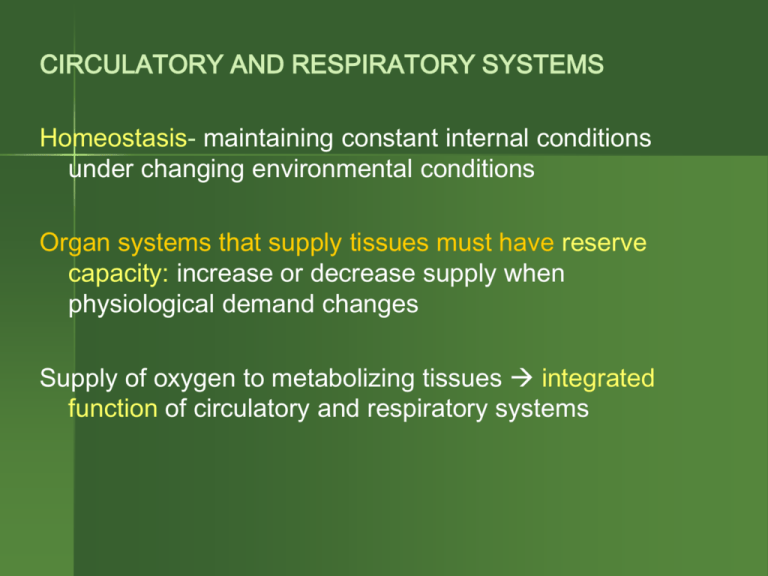
CIRCULATORY AND RESPIRATORY SYSTEMS Homeostasis- maintaining constant internal conditions under changing environmental conditions Organ systems that supply tissues must have reserve capacity: increase or decrease supply when physiological demand changes Supply of oxygen to metabolizing tissues integrated function of circulatory and respiratory systems Integration of cardiac and respiratory function with demands of metabolizing muscles is performed by the autonomic nervous system fluctuation in blood pressure drops with distance from heart – pressure damping blood pressure drops with distance from heart Blood pressure - systole vs. diastole - systole - maximum contraction - pressure generation - diastole - relaxation – refilling of chambers with venous blood Increasing cardiac output - reserve capacity 1. increase stroke volume - volume pumped per contraction 2. increase heart rate Blood pressure is affected by: a. amount of heart contraction b. stroke volume c. peripheral resistance - all circulatory routes not open simultaneously - more routes open lower resistance - autonomic nervous system controls heart contractions and patterns of blood flow For 2 subjects, measure: 1) Resting heart rate, systolic, and diastolic blood pressure 2) Exercise vigorously for 3-5 minutes 3) Measure blood pressure and heart rate immediately following exercise Expected changes after exercise: Blood pressure: depends on fitness level - well-conditioned individuals: blood pressure may decrease due to opening up more routes for blood flow to muscles – reduced peripheral resistance - sedentary individuals: increased ventricle contraction increase blood pressure Pulse rate: increase; amount varies based on fitness RESPIRATORY RESERVES – ability to increase volume of gas exchanged when needed Negative pressure breathers - aspiration mechanism - partial vacuum in lungs created by expanding volume of chest cavity Amount of expansion increases with demand: 1) low level activity - diaphragm alone 2) moderate levels of activity - intercostal muscles expand, compress rib cage 3) extreme activity - abdominal, trunk muscles move viscera up and down Reserve capacity – two ways to increase gas exchange 1) increase tidal volume - volume of gas moved in and out of lungs in each breathing cycle 2) increase breathing rate Tidal volume - increases from rest exertion - increased inhalation – inspiratory reserve - increased exhalation – expiratory reserve inspiratory reserve resting tidal volume maximal tidal volume expiratory reserve The maximum tidal volume is called vital capacity - the greatest volume of air that can be moved in and out with a single breath Spirometer - measures only expiration volumes; do not inhale 3 measurements: A) inhale normally, then expel as much air as possible into spirometer resting tidal volume + expiratory reserve B) exhale normally, then expel as much air as possible into spirometer expiratory reserve only C) inhale maximally, then expel as much air as possible into spirometer vital capacity = the sum of inspiratory reserve, expiratory reserve, and tidal volume A – B = resting tidal volume C – A = inspiratory reserve Compare your vital capacity with average: Dubois chart – average (expected) vital capacity for man or woman of given height and weight Look up your weight and height – chart gives you surface area of body (in square meters) - multiply x 2 for women, x2.5 for men = expected vital capacity in Liters (gender conversion factor) - calculate % difference from average - your measured vital capacity vs. the expected average for someone of your size Example: - your vital capacity is 4.25L (measured with spirometer) - expected vital capacity is 4.0L (calculated from Dubois chart) % difference = (4.25- 4.0)/ 4.0 x 100 = (0.25/4) x 100 = + 6.25% RESPIRATORY RATE AND VOLUME Total volume of gas exchange = volume x frequency of breaths Respiratory minute volume = tidal volume x number of breaths/minute Measure respiratory rate before and after vigorous exercise Estimate: Resting minute volume = resting tidal volume x resting respiration rate Exertion minute volume = vital capacity x after exercise respiration rate TO DO: 1. Table 1 and 2. Collect BP and heart rate data before and after exercise for 2 members of your group. 2. Table 3 and 4. Measure respiratory volumes and % deviation from average for 2 individuals. Take the average of 3 readings for each measured volume. 3. Table 5. Respiratory minute volume, before and after exercise. TO TURN IN NEXT WEEK: 1. Tables 1-5, and paragraph of interpretation of each. What do these data tell you about the mechanics, function, or reserve capacity of the heart and respiratory system? How does the autonomic nervous system affect these systems? Why?
